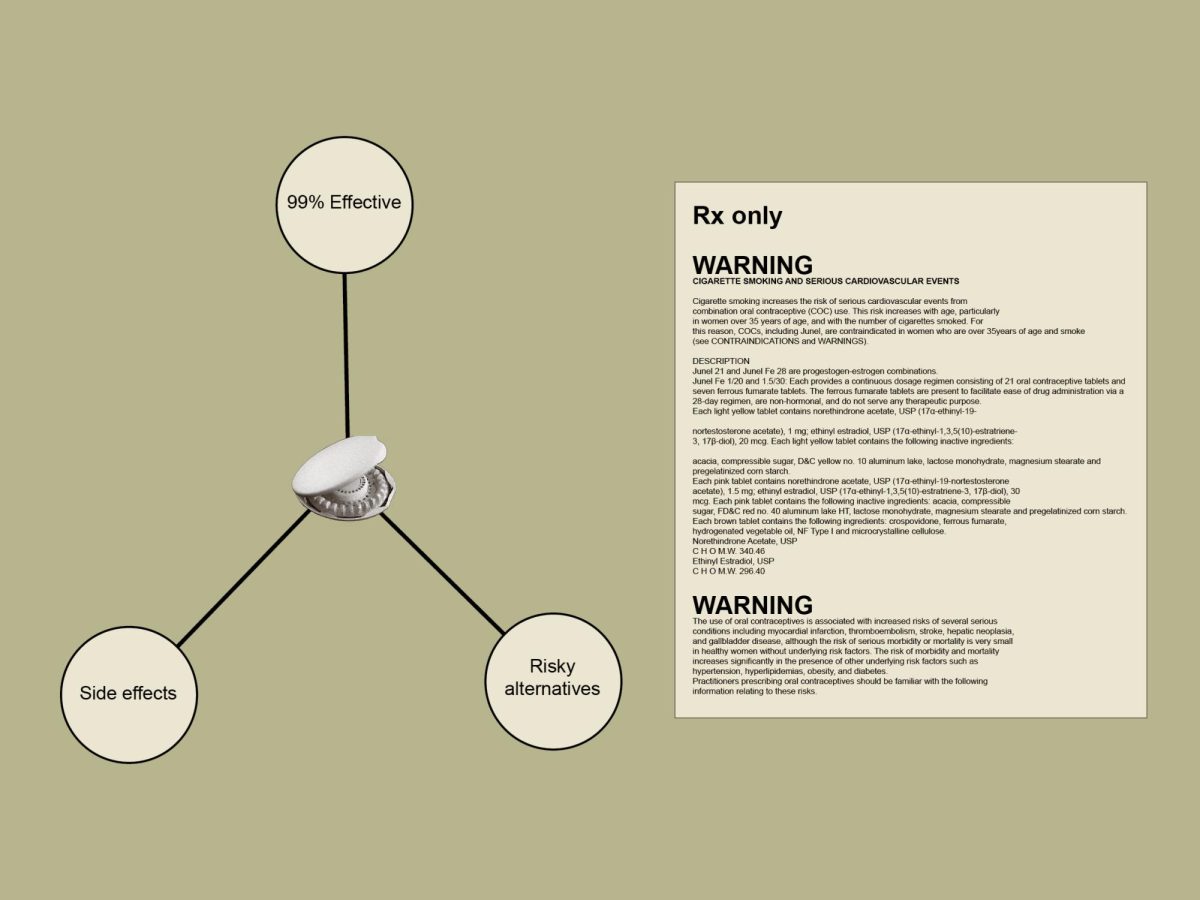The other day, I had a sickening headache. I can’t definitively attribute my headache to any one cause, but I had a strong suspicion as to what the culprit was: the female contraceptive pill.
Women are forced to deal with the negative side effects of contraception on a daily basis; we’re left to wonder if our boobs are hurting because of a tumor or a small pink pill. On the other hand, research into men’s birth control has stalled, leaving them off the hook for preventing pregnancy.
It goes without saying that this needs to change.
According to a 2017-19 survey performed by the Centers for Disease Control and Prevention, 65% of women aged 15-49 use some form of contraception, for reasons ranging from pregnancy prevention to period control. The most common forms of reversible female birth control — the pill, the arm implant and the intrauterine device (IUD) — are all notorious for their nauseating side effects which range from mild to severe, including the possibility of life-threatening blood clots and heart disease.
Since men are not the ones actually risking pregnancy, they’re far less likely to care — and for them to be willing to take any sort of birth control, the side effects are expected to be nearly non-existent.
For a complete list of side effects, the instruction sheet or manual provided with any form of birth control should be consulted. If you use the contraceptive pill Junel Fe, unfolding the side effects packet that comes with your pills reveals a sheet of paper so large you might consider using it as an extra blanket.
The sheet notes a disclaimer that “most side effects of the pill are not serious.” Nausea, vomiting, bleeding between menstrual periods, weight gain, breast tenderness, and difficulty wearing contact lenses are the most common side effects and “may subside within the first three months of use.”
The endless side effects of female hormonal birth control is something we take with our morning tea. In order to work properly, the pill must be ingested at the same time every day, so most women take it with their breakfast. As a result, I’ve suffered from work-obstructing headaches, nausea, mood swings, breast tenderness and fatigue. While I complain, I don’t actually do anything to change this, because what could I possibly do?
Most women are not jumping at the chance to become mothers at the wizened age of 18, and there is no alternative if we want the surefire protection against a condom. Even if I were to opt for a nonhormonal option — such as the copper IUD — there are a plethora of horror stories ranging from excruciating insertions, cervical infections and ectopic pregnancies.
Why has modern technology failed to give us a better alternative?
The quick-and-dirty answer is the patriarchy. While many might shake their heads at this answer or describe the patriarchy as a ‘hot-button’ word at which feminists seem to direct all their anger, it’s important to consider the following: Why hasn’t there been a need to take some weight off of women’s shoulders while men are just as complicit in the catalyzation of pregnancy? The more complex answer involves the fact that male birth control has been proven to be harder to develop.
Currently, there are only two approved forms of male birth control: vasectomies and condoms. According to a 1990 study conducted by the World Health Organization, hormonal medication for males is “trickier” because men produce high concentrations of sperm on a daily basis. Women, on the other hand, have easy-to-predict ovulation cycles.
Several scientists have experimented with the idea of rewiring the way male contraceptives operate; rather than halting the functions of hormones like testosterone, they have considered making sperm production slower and less efficient at “swimming.” No substantial findings have yet to be published.
Why hasn’t there been a need to take some weight off of women’s shoulders while men are just as complicit in the catalyzation of pregnancy?
In 2016, researchers at the Centre for Reproductive Medicine and Andrology conducted a study which concluded that the rate of side effects in male oral contraceptives was higher than what women typically experience using hormonal birth control. The experiment was shut down after a cost-benefit risk analysis; in addition to a slew of reported symptoms such as depression, acne and weight gain, the degree of symptoms that participants reported was significantly worse than that of women.
Why stop the experiment there? Herein lies the “patriarchy” part of the answer. If our society were truly to treat females and males equally, there would be far more extensive research on the topic of male birth control. We would attack the problem with rigorous testing, the same way we approach the rest of America’s health issues. Yet, after a couple of unsuccessful trials, men drop like flies and testing companies throw up their hands, looking at each other in a stunning show of bystanderism.
The corporations that monopolize both birth control production and distribution have shirked accountability for far too long. Since men are not the ones actually risking pregnancy, they’re far less likely to care — and for them to be willing to take any sort of birth control, the side effects are expected to be nearly non-existent.
There is also a lack of social awareness about what happens every time we place a pill on our tongues or have metal pogo-looking sticks painfully inserted into our uteruses. Education on available birth control options is meager, and men are scarcely aware of what goes into the decision of taking it.
We live in a world in which sexual health education stops at the line where the information no longer concerns men, and they’re content to allow us to shoulder the burden alone — because we’ve done it for this long and because we don’t really have any other choice.
Developing male birth control may not be easy, but that is certainly a terrible excuse for why research has slowly grinded to a halt. The 2016 study was the latest study to involve human trials; there has since only been one other partially-promising trial involving mice, but it has yet to yield any results.
The responsibility for birth control must be doled out equally, and it should bother everyone — yes, even you — that in the decades since the first female pill was put on the market, we have failed to create a male equivalent.


